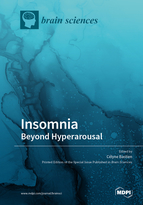Insomnia: Beyond Hyperarousal
A special issue of Brain Sciences (ISSN 2076-3425).
Deadline for manuscript submissions: closed (15 January 2020) | Viewed by 39875
Special Issue Editor
Interests: sleep; sleep disorders; insomnia; dreams; nightmares; depression; anxiety; treatment; COMISA; sleep deprivation
Special Issues, Collections and Topics in MDPI journals
Special Issue Information
Dear Colleagues,
The special issue will deal with pathophysiological signs of insomnia as well as with phenomenological ones. For example, is EEG still informative or which information shall be taken from the EEG to advance insomnia research? Does cognitive ‘hyperarousal’ really exist? Is ‘hyperarousal’ outdated? What happens to ‘hyperarousal’ after treatment? Should reduction in ‘hyperarousal’ be an endpoint to treatment efficacy? There is a paucity of data also related to those individuals at risk to not benefit from CBT-I. What should we propose?
This new issue on insomnia, as for insomnia individuals, will deal with a diversity of subjects. We welcome those researchers with exciting data on comorbid conditions to submit their paper as well as others with new approaches to the insomnia phenomenon. You exercise research in a clinical setting which provides data (EEG, PSG, MRI, etc) which might shed some light on the pathophysiology of insomnia, and your paper is welcome. You deal with cultural and/or social issues which might provide some insights on treatment efficacy and impairs daytime functioning? Again you are welcome to share your findings with us.
Another part of insomnia which remains quite unexplored, is in children part of this issue can easily be dedicated to sleep in children.
We aim to set forward new thinking about insomnia research, unchartered territories needing to be explored. Review, meta-analysis, pre-post treatment data, etc. are welcome.
Prof. Dr. Célyne H. Bastien
Guest Editor
Manuscript Submission Information
Manuscripts should be submitted online at www.mdpi.com by registering and logging in to this website. Once you are registered, click here to go to the submission form. Manuscripts can be submitted until the deadline. All submissions that pass pre-check are peer-reviewed. Accepted papers will be published continuously in the journal (as soon as accepted) and will be listed together on the special issue website. Research articles, review articles as well as short communications are invited. For planned papers, a title and short abstract (about 100 words) can be sent to the Editorial Office for announcement on this website.
Submitted manuscripts should not have been published previously, nor be under consideration for publication elsewhere (except conference proceedings papers). All manuscripts are thoroughly refereed through a single-blind peer-review process. A guide for authors and other relevant information for submission of manuscripts is available on the Instructions for Authors page. Brain Sciences is an international peer-reviewed open access monthly journal published by MDPI.
Please visit the Instructions for Authors page before submitting a manuscript. The Article Processing Charge (APC) for publication in this open access journal is 2200 CHF (Swiss Francs). Submitted papers should be well formatted and use good English. Authors may use MDPI's English editing service prior to publication or during author revisions.
Keywords
- insomnia
- EEG
- cognitive “hyperarousal”
- pathophysiology
- treatment
- children







